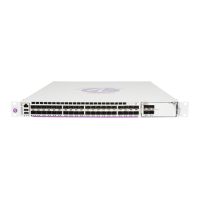Interface Configuration
7750 SR Interface Configuration Guide Page 133
fashion over member links in an LAG without awareness of the Vport, it can lead to packet drops
on one member link irrespective of the relative traffic priority on another LAG member link in the
same Vport. The reason is that multiple Vport instances of the same Vport on different LAG
member links are not aware of each other.
With a small number of subscribers per Vport and a great variation in bandwidth service offering
per subscriber (from mbps to gbps), there is a great chance that the load distribution between the
member links will be heavily unbalanced. For example, if the lag consists of two member links on
the same IOM, three 1Gbps high priority subscribers can saturate the 2Gbps Vport bandwidth on
one member link of the LAG. And all the while, twenty low priority 10Mbps subscribers that are
using the other link are significantly under-utilizing available bandwidth on the corresponding
Vport.
To remedy this situation, all traffic flowing through the same Vport must be hashed to a single
LAG member link. This way, the traffic treatment will be controlled by a single Vport instance,
and achieve a desired behavior where low priority 10Mbps subscribers traffic will be affected
before any traffic from the high priority subscribers.
Hashing per Vport
Hashing traffic per Vport ensures that the traffic on the same PON (or DSLAM) traverse the same
Vport, and therefore, it is the same member link that this Vport is associated with. The Vport
instances of the same Vport on another member links are irrelevant for QoS treatment.
The Vport in 7x50 is referenced via inter-dest-string, which can be returned via RADIUS. For this
reason, the terms hashing per inter-dest-string or hashing per Vport can be interchangeably used.
If the subscriber is associated with a Vport, hashing will be automatically performed per inter-
dest-string. In case that no such association exists, hashing will default to per-subscriber hashing.
In certain cases, S-vlan tag can represent Vport. In such a case, per S-vlan hashing is desired. This
can be implicitly achieved by the following configuration:
configure
subscr-mgmt
msap-policy <name>
sub-sla-mgmt
def-inter-dest-id use-top-queue
configure
port <port-id>
ethernet
access
egress
vport <name>
host-match dest <s-tag>
